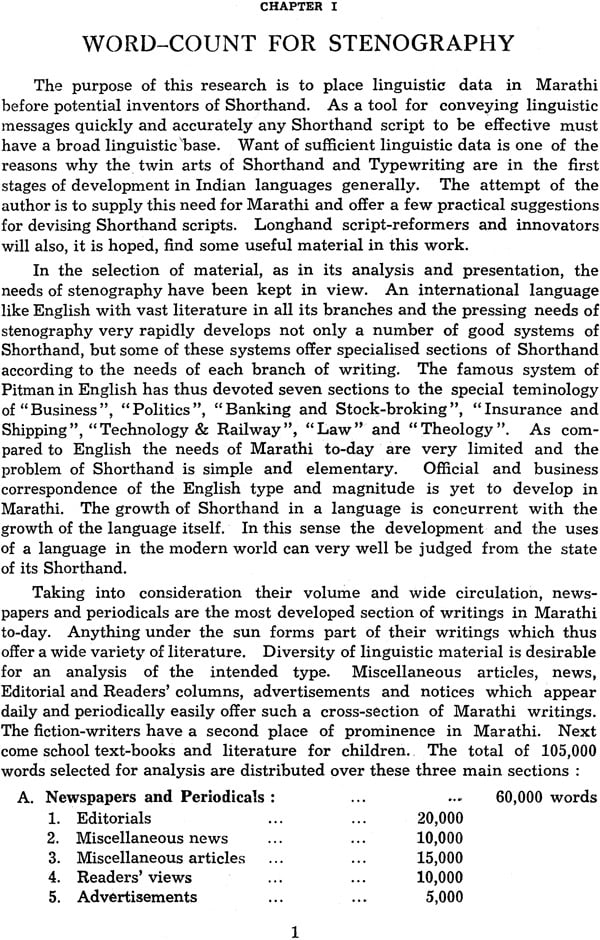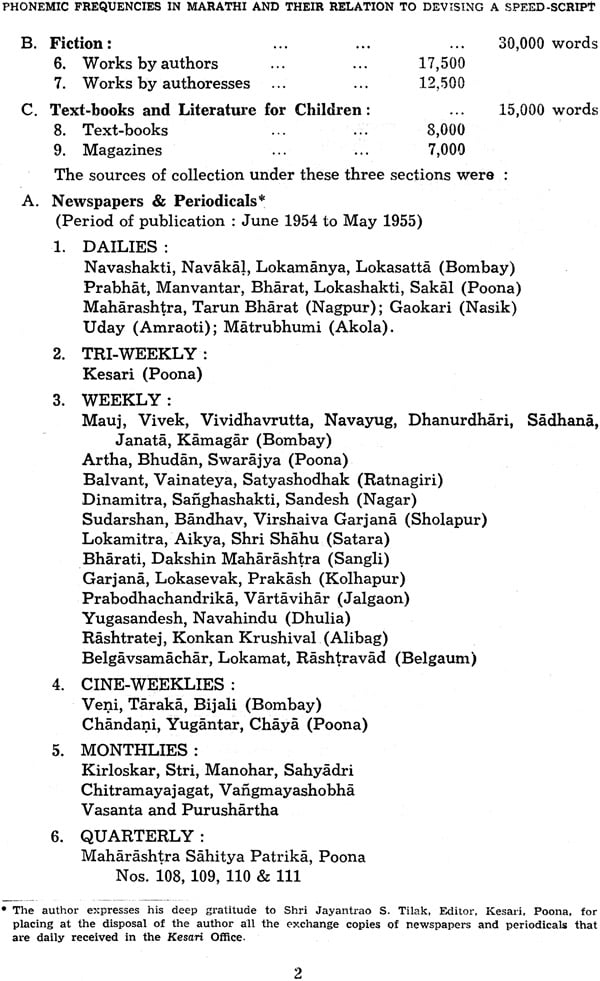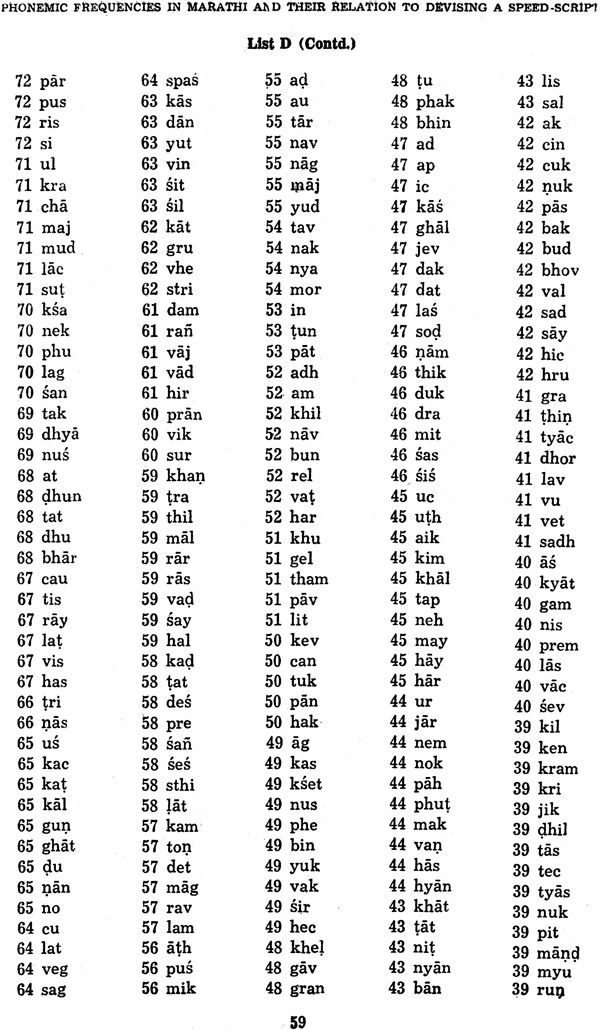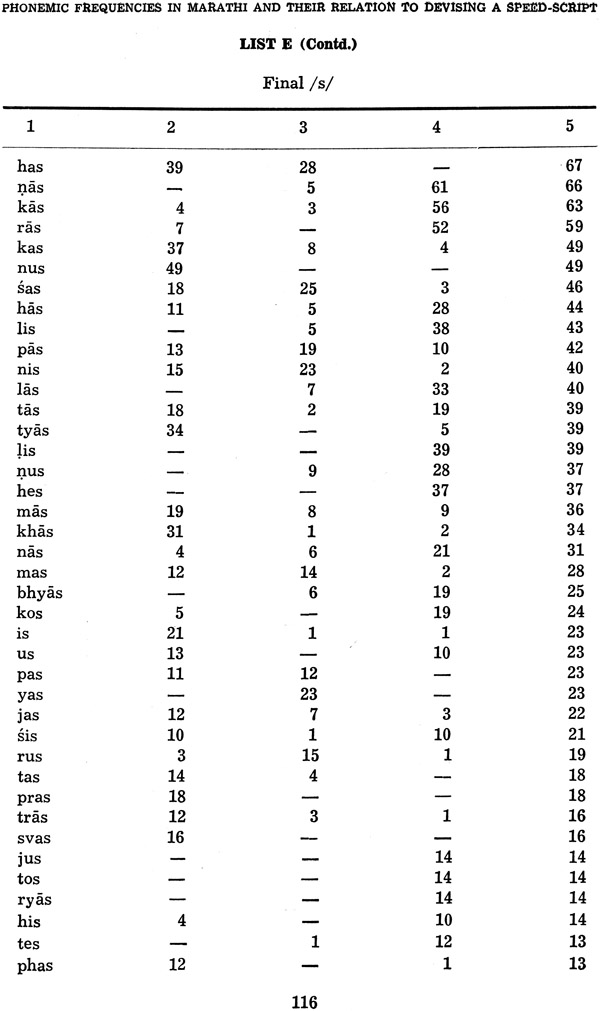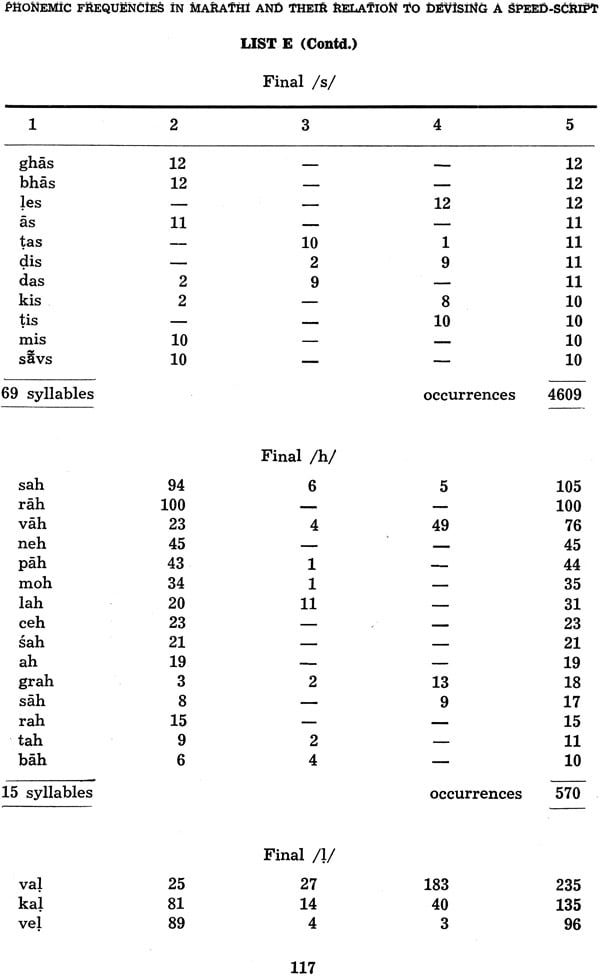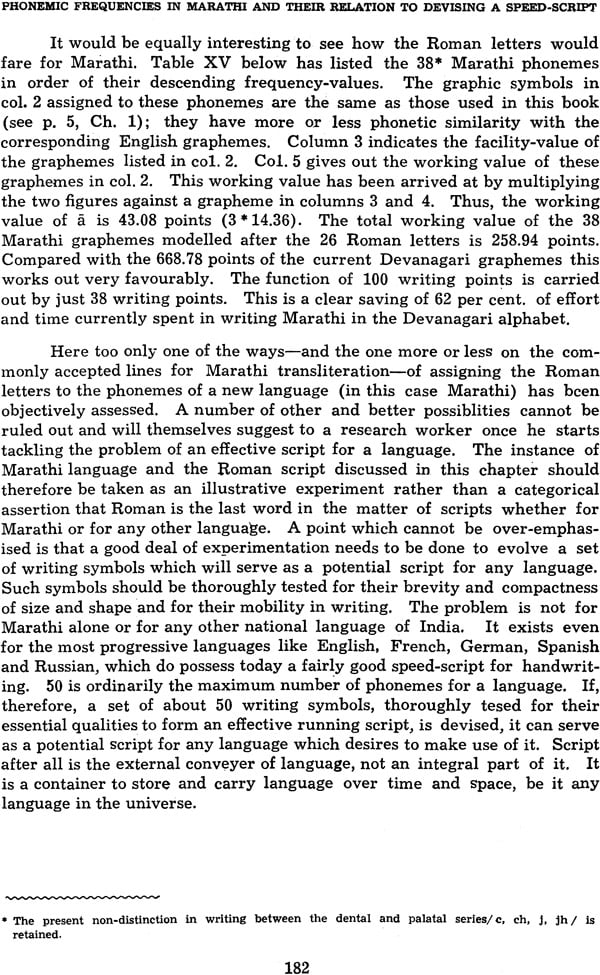
Phonemic Frequencies in Marathi and Their Relation to Devising a Speed-Script (An Old and Rare Book)
Book Specification
| Item Code: | NAM748 |
| Author: | Shriram Vasudeo Bhagwat |
| Publisher: | Deccan College Postgraduate and Research Institute |
| Language: | English |
| Edition: | 1961 |
| Pages: | 210 |
| Cover: | Paperback |
| Other Details | 10.0 inch x 7.5 inch |
| Weight | 330 gm |
Book Description
The present work inaugurates a new series entitled the Poona University and Deccan College Publications in Linguistics. The Deccan College Postgraduate and Research Institute came into existence in 1939 as a nucleus for the first of the regional Universities to be established by the Government of Bombay at Poona in 1948; its three departments of Linguistics, Archaeology and Ancient Indian History, and Sociology-Anthropology were recognised as ex officio departments of the Poona University, and on the basis of work accomplished during the past two decades, expanded with generous assistance from the University Grants Commission and the Government of Maharashtra (and formerly of Bombay). The Department of Linguistics has been principally responsible for undertaking the monumental project of compiling a Dictionary of Sanskrit on Historical Principles with financial assistance from the Union Government, and the Language Project (1954-59) with financial' aid from the Rockefeller Foundation of New York. Dr. Bhagwat's dissertation deservedly inaugurates this series, for it is the first major work completed on the phonemic and morphemic analysis of any language mentioned in the eighth schedule to our Constitution, and the first to be published after the significant expansion of the Department effected in 1960.
Dr. Bhagwat was Secretary of the Language Project when he first undertook this analysis, and he completed it while he was holding the post of Registrar at the Deccan College. When he approached me to guide him in his Ph.D. work I happened to be a Member of a Committee appointed by the Ministry of Education, Government of India under the Chairmanship of Sri Kakasaheb Kalelkar for considering the problems of evolving a common shorthand system for Indian languages and devising of a suitable typewriter for them. I suggested to the Committee that a great deal of scientific analysis of phonemic and morphemic frequencies of Indian languages was a condition precedent to any action that could be recommended on the evolution of speed-writing systems for them. This was readily accepted and the Ministry took steps to have this analysis conducted at various University centers in India. In the meantime I suggested to Sri Bhagwat the possibility of his undertaking this analysis for Marathi as part of his Ph.D. dissertation; the Advisory Committee of the Language Project sanctioned some financial assistance for the carrying out of the preliminary analysis and the cost of the statistical analysis which was kindly undertaken by the Gokhale Institute of Politics and Economics. After Dr. BHAGWAT submitted his thesis to the University the Government of India entrusted the work of the phonemic and morphemic analysis of Hindi to the Deccan College. This assignment was completed in 1960 and the report was submitted to the Ministry of Education at New Delhi. It is not unlikely that that report may find a place in this new Series in due course. Similar work has been completed on Gujarati (Gujarat University) and on Kannada (Mysore University) and work is progressing on the other languages. The Deccan College has not only been a pioneer in this field, but has also carried out the statistical analysis with the use of the special sorting and verifying machines which the Language Project and the Government of Bombay provided. In addition, the Department was requested by the Government of India to supervise the work done by various Universities entrusted by them with this analysis and to train the scholars selected by the Universities.
The Deccan College feels proud that this pioneering study of Dr. Bhagwat was accepted by the University of Poona for publication in this series and that suitable grants have been sanctioned by the University as well as the University Grants Commission towards the cost of this publication. It is hoped that the scientific analysis presented in this work will stimulate specialists in the field of shorthand systems to invent a suitable method of speed-writing which may become popular all over the country.
Contents
| 1 | Word-count for- Stenography | |
| Prefatory | 1-7 | |
| List A : Words with frequency of 10 and above in alphabetical order | 8-26 | |
| List B : Words with frequency of 10 and above according to frequency ranks | 27-34 | |
| Table I : Frequency distribution of words with their total occurrences | 35-37 | |
| Table II : Progressive total of words and their occurrences | 38-42 | |
| 2 | Syllables | |
| Prefatory | 42 | |
| Table III : Distribution of syllables | 43 | |
| List C : Syllables with frequency of 10 and above according to alphabetical order | 44-56 | |
| List D : Syllables with frequency of 10 and above according to frequency ranks | 57-63 | |
| Summary of Lists CoD and Tables IV - V | 64 | |
| Table IV : Distribution of syllables with their total occurrences | 65-69 | |
| Table V : Progressive total of syllables, their occurrences and percentages | 70-77 | |
| 3 | Morphemes | |
| Prefatory | 78 | |
| List E : Syllables according to final phonemes | 78-118 | |
| 4 | Open and Close Syllables | |
| Table VI : Distribution of open and close syllables according to final phonemes | 199-120 | |
| Table VII : Final phonemes of syllables according to frequency ranks | 120-121 | |
| List F : Close syllables according to central vowels and final phonemes | 122-134 | |
| 5 | Marathi Phonemes and Balbodh Letters | |
| Table VIII: Distribution of Vowels in one lakh words | 135-136 | |
| Table IX : Distribution of consonants in one lakh words | 137 | |
| Table X ; 38 Mara.tbi Phonemes according to frequency rank | 138-139 | |
| 6 | Mechanism of Handwriting | |
| Prefatory | 140-142 | |
| Table XI : Anatomical Description of Balbodh and English Alphabets | 143-149 | |
| Table XII (a) : Structure of Balbodh letters in terms 0f writing-effort | 150-151 | |
| Table XII (b) : Structure of English letters in terms of writing-effort | 152 | |
| Characteristics of Balbodh | 153-156 | |
| Characteristics of English script | 156-158 | |
| 7 | Alphabets in Motion | |
| Prefatory | 159 | |
| Experiment No.1 | 160-161 | |
| Table XIII: Structure-points and speed-points of Balbodh and English graphemes | 162-163 | |
| Results of Experiment No.1 | 164 | |
| Experiment No.2 | 165-170 | |
| Results of Experiment No.2 | 171-173 | |
| 8 | Mobility of a Script | |
| Two fallacies about Devanagari | 174-175 | |
| Ingenious device of Barakhadi | 176 | |
| Essential requirements of a National Script | 177-178 | |
| 9 | Relation of Phonemic Frequencies to Graphemes | |
| Prefatory | 179-180 | |
| Table XIV-Regrouping of Devanagari letters for Marathi | 181 | |
| Table XV -Assessment of English transliteration for Marathi | 183 | |
| Table XVI-One possibility of a scientific Script for Marathi | 185 | |
| Speed-scripts for our national languages | 186 | |
| Shavian conception of a reformed Script | 186 | |
| Boon of a Stream-lined Script for Marathi | 187 | |
| 10 | Shorthand | |
| Prefatory | 188-189 | |
| Shorthand in India | 190-191 | |
| Principles of Shorthand | 191-193 | |
| Characteristics of Pitman System and difficulties of Short-hand-Writers | 193-195 | |
| Bibliography | 196-198 |
